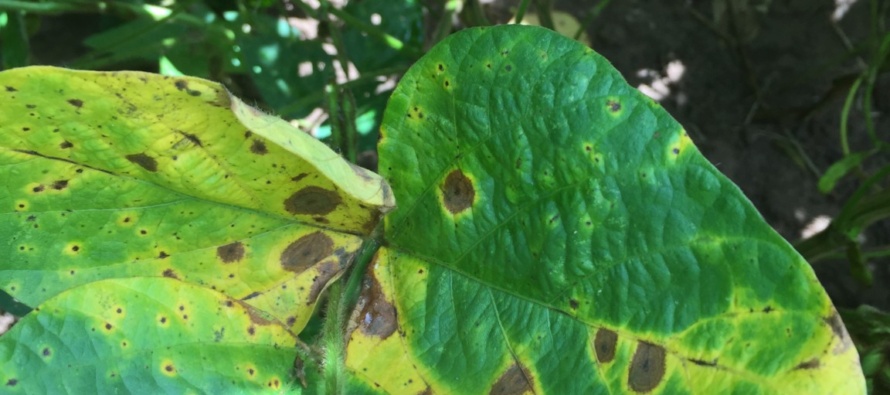Soybean Disease Update: August 21, 2016

Related Articles
- 2010 Soybean And Corn Variety Trial Data 3
- Rice Variety Trial Results For 2010, Plus Rice Research Report 0
- Evaluation of Peanut Prescription Rx Program in Mississippi 0
Latest Tweets
For many of the diseases outlined below, dry, windy, sunny weather would go a long way towards reducing the incidence and severity of each of the diseases. In most cases, a fungicide application would not reduce the disease, especially in the case of brown spot and target spot once the diseases are observed.
Anthracnose
Over the past several weeks I have received photos of pods with lesions. Round to oval lesions with black fruiting bodies on the outside of the pod have become more common over the last few years. Anthracnose is much more of a late-season disease and normally produces fungal fruiting bodies on the main stem. High humidity in the crop canopy can trigger formation of anthracnose lesions on the pods. One important thing to note: the anthracnose lesions on pods are NOT the cause of sprouting soybean seed. Therefore, making a foliar fungicide application to reduce the losses associated with anthracnose thinking this will impact sprouting seed is pointless.
Diagnosing the pod lesions should be done with a hand lens. Look for the presence of black fruiting structures with small protruding black pins or hairs. The almost concentric rings can be mistaken for pod and stem blight as well as target spot. However, I have not observed target spot occurring on pods in the past.

Telling Septoria brown spot apart from soybean rust can be difficult. The soybean rust is circled, while the remainder of the lesions are the result of brown spot.
Septoria brown spot
Following the two weeks of rainfall, Septoria brown spot has become much more widespread across MS. Brown spot is a normal low to middle canopy inhabitant. Rarely does the disease impact the upper canopy. Last Thursday and Friday while touring south MS, brown spot was continuously observed in the middle canopy in almost every soybean field from Yazoo City to the coast. Brown spot is a disease that normally does not require attention until observed in the upper canopy.
Lesions can easily be mistaken for several other diseases including soybean rust. Observe the underside of the leaf with a hand lens rather than attempting to diagnose diseases with the symptoms on the upper leaf surface. Brown spot can develop a lesion that has the appearance of soybean rust pustules. However, soybean rust pustules look similar to little bumps or pimples and regularly produce sporulation. Brown spot lesions will range in color from brown to maroon and will appear slightly raised through the hand lens.
Target spot
In general, target spot is a disease that occurs during periods of high humidity. The excessive rainfall for the past few weeks has clearly triggered a bloom of target spot in numerous soybean fields. Target spot generally defoliates the plant in the lower to middle canopy. But, in some rare cases, target spot lesions can develop on stems as well as petioles and where the petiole attaches to the main stem.
Target spot is generally an inhabitant in the lower to middle canopy. Rarely will the disease move higher into the canopy. In some years, the presence of target spot can be rated in variety trial plots. However, in most years the disease is not present in fungicide efficacy plots so a data set on managing the disease is not available. Some efficacy plots have been rated for the presence of target spot following R2, R3 and some R5 applications. Preliminarily, plots were rated at approximately R5 (following the R3 application) and no fungicide appeared to eliminate the presence of target spot.
Even though soybean rust has been observed in 36 counties as of this morning (8/21), the disease has been difficult to find in some counties. Many of the positive counties contained soybean rust on extremely protected kudzu or soybean (e.g., shaded areas). To date, soybean rust has only been observed on soybean in six of the 36 counties reported (Choctaw, Jefferson Davis, Jones, Rankin, Simpson, and Winston). The other 30 counties were all observed on kudzu. However, following the last two weeks of wet, generally cooler weather, I expect additional soybean rust to observed throughout MS in the coming days and weeks. However, unless the soybean fields were planted extremely late the soybean fields are likely not at risk
How does this year stack up to other years? By this time, August 21, in each of the previous five years, soybean rust had been observed in:
2015 = 4 counties
2014 = 0 counties
2013 = 11 counties
2012 = 11 counties
2011 = 0
The soybean fields where soybean rust has been observed this season are all in advanced R5 growth stages. Soybean plants that have reached R5.5 are generally considered to be out of the woods as it takes several weeks for inoculum to build up and infect plants in the field.
The most important thing to do is scout younger soybean fields in earlier reproductive growth stages for the presence of the disease. Be mindful that the pustules are formed on the underside of the leaf and can easily be observed with a 20x hand lens. The aboveground foliar symptoms look too much like several other diseases, included brown spot and downy mildew to tell them apart with any certainty based on the top of the leaf symptomology.







Let me tell You a sad story ! There are no comments yet, but You can be first one to comment this article.
Write a comment